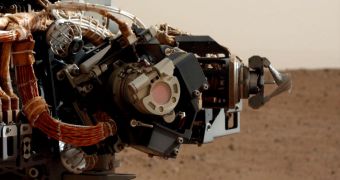Since touching down at Bradbury Landing, the Mars Science Laboratory (MSL) rover Curiosity has traveled more than 109 meters (358 feet). Now that the driving equipment has been proven operational, mission controllers plan to spend the next few days commissioning the tools on its robotic arm.
Experts at the NASA Jet Propulsion Laboratory (JPL), who manage MSL for the agency's Science Mission Directorate, say that the commissioning phase for the instruments on Curiosity's 2.1-meter (7-foot) robotic arm will last between six and ten days.
On Wednesday, September 5, the rover extended its arm for the first time, but these mobility tests are just the beginning. Bringing the tools it holds into operation is a major priority for the science team.
The most important scientific instruments on the robotic arm are the Alpha-particle X-ray spectrometer (APXS) and Mars Hand Lens Imager (MAHLI). The former is capable of bombarding target areas with alpha particles, and then scans the spectra of X-rays that are produced as a result.
The latter is a microscopic imager, destined to study rocks and sand. It can illuminate its own targets, using both white light and ultraviolet light-emitting diodes (LED). The robotic arm also features a drill and a scoop for handling soil samples.
“We will be putting the arm through a range of motions and placing it at important 'teach points' that were established during Earth testing, such as the positions for putting sample material into the inlet ports for analytical instruments,” expert Daniel Limonadi says.
“These activities are important to get a better understanding for how the arm functions after the long cruise to Mars and in the different temperature and gravity of Mars, compared to earlier testing on Earth,” he goes on to say.
Limonadi holds an appointment as the lead systems engineer for Curiosity's surface sampling and science system, at the JPL, in Pasadena, California. He explains that the current stop is made at a time when the rover is already a quarter of the way to Glenelg, its first science target.
Glenelg, located around 400 meters (1,300 feet) away from Bradbury Landing, was selected because it is an outcrop where three different types of rocks meet. The area will allow Curiosity to use most, if not all, of its instruments.
“We knew at some point we were going to need to stop and take a week or so for [robotic arm] characterization activities. For these checkouts, we need to turn to a particular angle in relation to the sun and on flat ground,” JPL MSL mission manager, Michael Watkins, adds.
“We could see before the latest drive that this looked like a perfect spot to start these activities,” he concludes.

 14 DAY TRIAL //
14 DAY TRIAL //